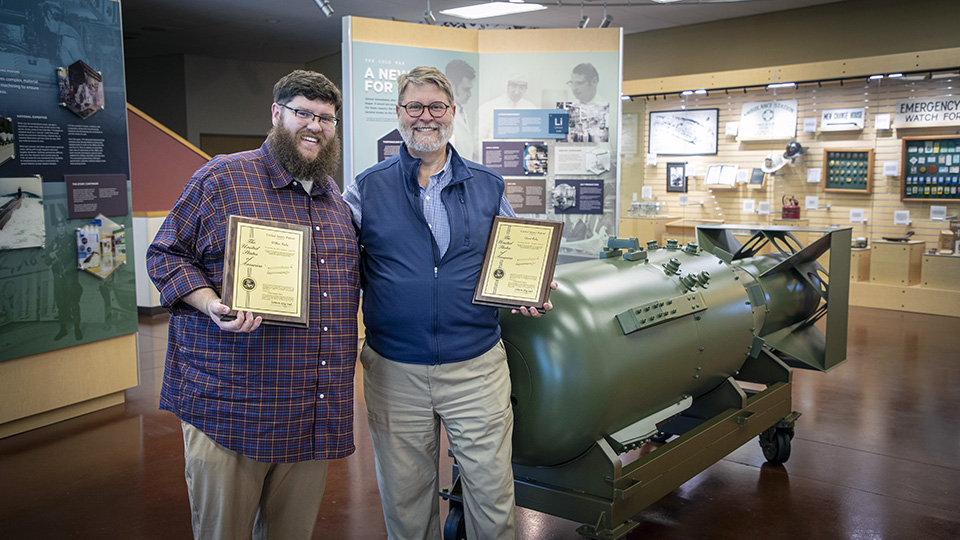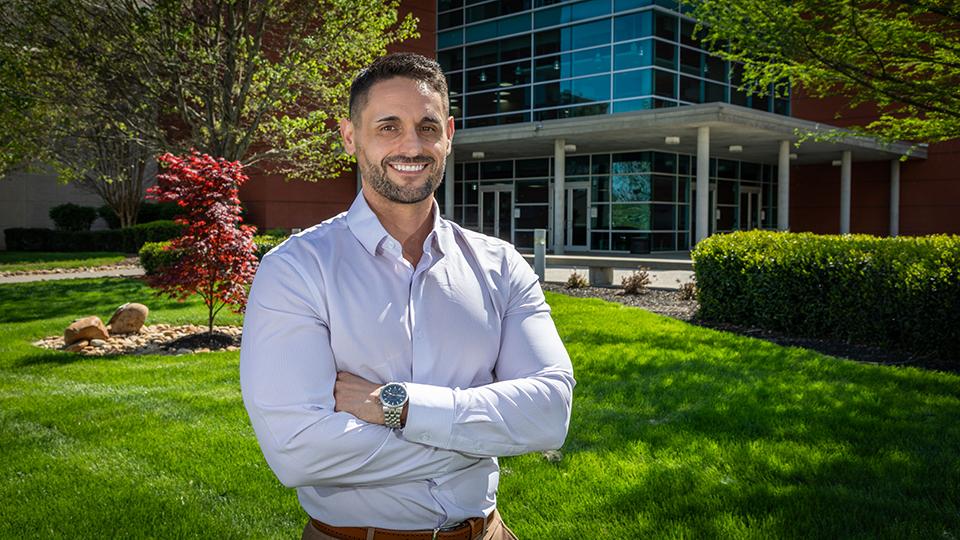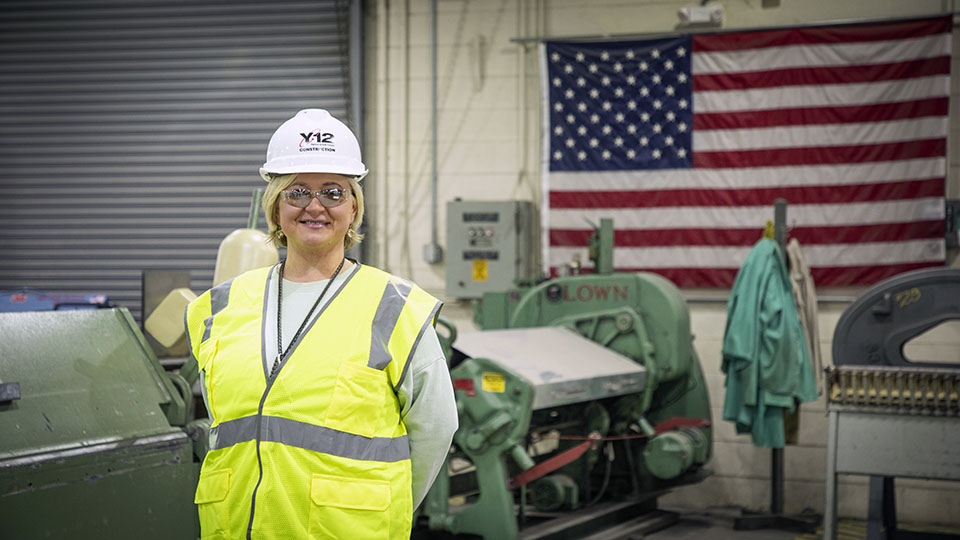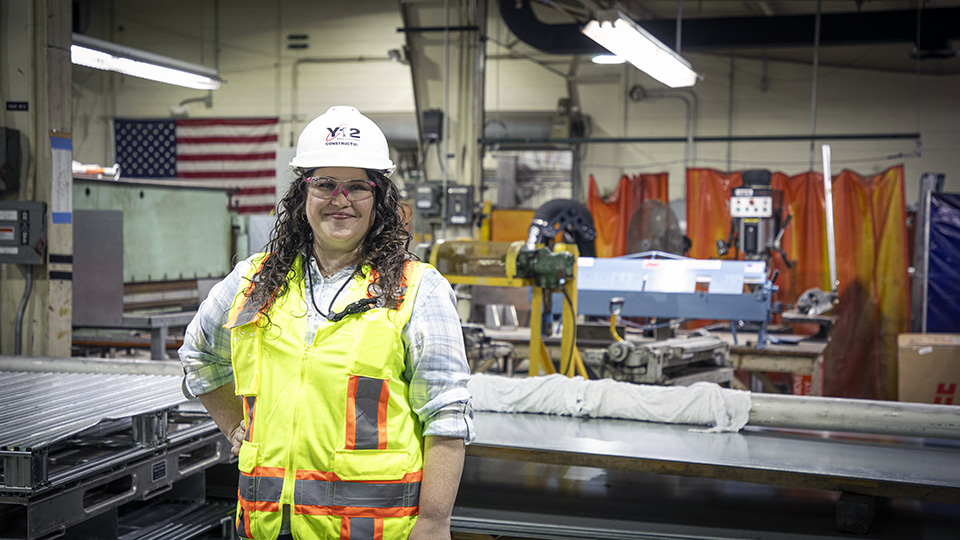Y-12 Blog

Will (left) and Ed R..(right) showcase the plaques they received for their joint patent, “Method of Making an Annular Radioisotope Target Having a Helical Coil-Shaped Foil Ribbon Between Cladding Tubes.”
As an engineer and researcher for more than 35 years at Y‑12, Ed R. has held many roles. He certainly understands the importance of continuous improvement through constant evaluation, research, and development of new processes and technologies. Working with the Technology Transfer Office, he has spearheaded and received 34 patents stemming from his work.
His most recent patent, though, just might be his favorite.
Forming a father‑son team
Ed’s son, Will, had just started working as a systems engineer in Y‑12 Development at the time Ed had begun working on a project related to annular, or tube‑shaped, radioisotopes. While Will was waiting on his security clearance, Ed thought this project would be a great opportunity for Will to gain experience and learn about Development.
“When this idea came to mind, I jumped at the chance,” said Ed. “It was an opportunity for us to work together on something, while also providing Will with important experience and education.”
They quickly set up a process to work together on the project and met daily.
“Getting the chance to work with my dad on this project was really cool,” said Will, now shift technical advisor. “Having just transferred to Y‑12 and waiting on my clearance, it was an amazing opportunity to do work on new technology while I was working on my prerequisites as a systems engineer.”
Developing a new and improved technology
Process improvement is crucial to the Y‑12 mission, especially when an improved process can save time and increase worker safety. The duo established those goals when they began working on a new method for the annular radioisotope assembly process.
The previous method uses a flat foil that is wrapped into a C‑shape around an inner tubing. The foil then has an outer tube slid over it, and the ends are welded shut to prevent foil movement. The process concludes by expanding the inner and outer tubes to obtain a final desired dimension. This method can cause quality issues with the final product and can increase worker exposure times due to potential buckling of the foil.
“We were able to take an in‑depth look at this labor‑intensive process and then find ways to improve it,” Ed said.
Working together daily, Ed and Will developed an improved and more efficient technology and method. The new method simply cuts the foil that wraps around the inner tube into a helical coil or spring. The helical coil can be twisted to tightly grip the inner tubing with edges on the foil that lock together when tightened. Conducting the process through this new and improved technology prevents gaps and overlaps of the foil that would otherwise hurt the quality of the final product. The helical design speeds up the overall process by eliminating the potential for buckling of the foil, which reduces exposure time to employees.
“This technology brings the ability to create medical isotopes in a repeatable and effective way with an extremely high percentage of usable material and minimal waste,” Will said. “It brings a ton of potential to both the NSE [Nuclear Security Enterprise] and the medical industry.”
Receiving a patent
As the development of this new technology and method were coming to a close, Ed began showing Will how to conduct patent searches to ensure their method was unique and how to ensure it was protected through the Y‑12 Technology Transfer Office.
“Having no experience with the patent process at Y‑12, I was very impressed with how streamlined and simple the process is,” said Will. “The Tech Transfer group knows how to get the ball rolling and help guide you through everything.”
Once it was confirmed that their approach was completely new, they proceeded with filing a patent through the Technology Transfer Office. This patent was Will’s first, and working as a father‑son team made the success that much better.
“I loved every second of it,” Ed said. “Your first patent is truly a milestone, and I have so much pride for Will and how big of an accomplishment this was for him. It’s always great to see your kid succeed, but being able to work together in the process of it all made it so much more meaningful.”
Will said, “I had wanted to work at Y‑12 since I was a little kid. Having grown up hearing about all of the cool projects my dad had been part of, it was extremely special to finally be part of one.”
The new Y‑12 technology can be useful within the NSE, but it has potential to have a large impact within the medical industry as well. Hospitals worldwide use radioisotopes in medicine and for diagnostic scan procedures. Y‑12’s technology is applicable to all isotope productions, so there is potential to commercialize this technology to other industries.
“At Y‑12, we get to go beyond the leading edge of technology,” said Ed. “I’m grateful we get to develop things that people will be using and reading about for decades to come.”

In his short time in East Tennessee, Tyler M. has already experienced the intense fan noise in Neyland Stadium and enjoyed the serenity of the Smoky Mountains. Now his objective is ensuring Y‑12 employees complete FY 2025 Stockpile Programs mission work.
When “UT” is mentioned in East Tennessee, the default assumption is in reference to the University of Tennessee. This implication is new for the senior director of Stockpile Programs, Tyler M. As an Amarillo native, his first thought is the University of Texas, but he is slowly adapting to equating “UT” to the “University of Tennessee.” It helps his fiancée is a UT (yes, Tennessee) graduate.
Tyler, a Pantexan for 13 years, joined Y‑12 in November 2024. He replaced Reed Mullins, the current vice president of Mission Execution. Tyler is excited to be on the East Tennessee side of the Nuclear Security Enterprise mission, surrounded by mountains and rivers. “I love having the opportunity to learn about Y‑12’s production capabilities and material streams. At Pantex, we received Y‑12’s finished product. It is enlightening to witness the complexity of manufacturing the mission deliverables.”
Tyler realizes there will be challenges ahead as Y‑12 adapts to the growing workload. “Stockpile Programs is responsible for the strategic planning of scope, schedule, and cost associated with weapon deliverables at Y‑12. We recognize the demand will continue to increase and require a more agile and efficient approach to mission execution,” he said. “I am fortunate to have a strong and knowledgeable team capable of this critical endeavor.”
Tyler, who has a B.S. in mechanical engineering and an M.S. and Ph.D. in systems and engineering management, started his career as a tool design engineer at Pantex. He graduated from the Sandia National Laboratories Weapon Intern Program in 2017, during which time he visited Y‑12 for the first time. After his WIP graduation, Tyler worked as the manager responsible for the weapon programs’ safety basis. Following this role, he was a weapon program manager and observed the star stamp of the first production unit. In 2022, he was selected to be the senior technical advisor for production for NA‑122, also known as the Office of Stockpile Sustainment, at the National Nuclear Security Administration Headquarters in Washington, D.C.
As a former West Texas A&M University baseball player, Tyler understands the importance of teamwork and recognizes it as the most impactful CNS value. “Teamwork is required to successfully execute our mission. The three additional CNS values of trust, integrity, and respect provide a strong foundation for teamwork.”
Tyler is ready to support the mission in his new role and said, “It takes the whole site to make Y‑12 successful. Let’s continue addressing FY 2025 milestones and have a successful year.”

The Y-12er spotlight shines on one of our own, Stacy P., Y-12 Construction laborer. It takes all Y-12 employees to make the mission happen successfully and safely. All views and opinions are the employee’s own and do not necessarily reflect those of CNS.
Stacy P. has had many roles in her life: teacher, mother, nurse assistant, and construction laborer. She started her construction career with UCOR at the former K‑25 plant (East Tennessee Technology Park) in Oak Ridge before coming to Y‑12, where she has supported construction work alongside other classifications of construction craft employees for 7 years. She readily shares the lessons she’s learned with her coworkers.
“I’m here to help my team, and I like to look after them,” she said. “I often remind them to ‘think about that’ before they make a final decision.”
Stacy’s advice to “think about that” is her way of reminding coworkers to press pause before jumping immediately into action. She thinks of the team she works with as her family, and for her, a family works in sync, understanding one another’s strengths and weaknesses. She brings experience with situations where quick decisions can have lasting impacts to her current role.
“Stepping back provides a chance to think through the what‑ifs, the ‘plan B,’ and the potential consequences, because everything changes, sometimes minute‑by‑minute, on a Construction job. No one can settle into a routine,” she said.
Stacy emphasized that on a construction site, even if the jobs look the same, every day is slightly different than the day before. Routine tasks could turn into serious situations at any time based on even the slightest variable. Active communication is key to ensuring a workday goes smoothly.
“We all have to be on the same page,” she said. “If not, something could be unsafe and the job could be shut down, or worse, someone could get hurt. We all are responsible for holding space for each other and working to ensure the job is done the right way, every time.”
What is your favorite aspect of your work environment?
The feeling of making a positive impact through our work; the opportunity to learn new skills and grow professionally; and having a supportive and collaborative team.
What value, principle, or pillar of the CNS mission success model drives you to be successful?
I like being recognized for my skill and talent. I appreciate that a significant project could be assigned to you unexpectedly based on your potential and current skills rather than on your job title and current role.
What work advice would you offer to someone who is new at Y‑12?
Be open and honest. Speak your mind, share ideas, and ask questions no matter what. Standing up and speaking out is hard, but important. What you think and share out loud could make the job safer or easier for you or someone else. Never be quiet, settle, or get complacent. Communicate everything to make sure everyone is on the same page before you start work.
Who in your life has inspired you most and why?
My family has inspired me. They always have my back and provide encouragement. They provide an extra push when I need motivation. At work, I do the same thing for my team, pushing them to improve, having their backs, and giving encouragement.
What’s an example of how teamwork has helped you in your current role?
I encourage my team to speak up, but I also remind them to try to leave hard feelings outside the blue line. Open and honest feedback lets a team know they can speak comfortably with each other. Hard feelings shut teams down. We have a job to do, and good communication helps us all get home safe.

Field Engineering Administrator Kaitlyn W. shares her thoughts on teamwork as part of a series of Y‑12 stories highlighting our Construction team.
The Y‑12er spotlight shines on one of our own, Field Engineering Administrator Kaitlyn W. It takes all Y‑12 employees to make the mission happen successfully and safely. All views and opinions are the employee’s own and do not necessarily reflect those of CNS.
A conversation with her dad placed Kaitlyn W. on the career path she is on today. As a girl, she had set her sights set on being a veterinarian.
“My dad is an electrician, and he pointed out that he thought I was very mechanically inclined,” she said. “He asked why I wasn’t pursuing engineering instead. That shifted my mindset of what I thought I was capable of and planted the seed of ‘I can do this.’”
Kaitlyn got involved with STEM (science, technology, engineering, and math) programs at school, where the knowledge of what she could do grew.
“These programs taught me STEM‑related career goals were achievable,” she said. “As an 8‑year‑old girl, I thought careers like this were something you only saw in the movies.”
Today, as a field engineering administrator in Construction, Kaitlyn said her engineering knowledge informs how she can best support field engineers. It also comes in handy for the work she does to help plan small engineering projects.
Kaitlyn also manages the General Services Administration fleet of vehicles for Construction, overseeing 68 vehicles for the group’s use.
“The vehicles are one more tool for our construction workers,” she said. “I help to make sure those tools are running properly and that each of our workers has the right tool for the job.”
One of the things Kaitlyn finds interesting about working at Y‑12 is the site’s rich history, which is sometimes unearthed during construction tasks. But she noted that even for those who may never find themselves in a construction zone, the imprint of the past is still very visible around the site.
“It’s fascinating that we have a lot of historical items preserved in places like New Hope Center and Alpha 3 (Building 9201‑03),” she said.
Another aspect of the site that stands out to Kaitlyn is the number of opportunities and services offered on site. “It’s interesting to see how Y‑12 functions like its own little town behind the blue line. Everything you need is here.”
How has working for CNS changed or reinforced your thoughts on our mission?
Construction literally lays the foundation for Y‑12. Without buildings, roads, electricity, machinery, equipment, etc., we wouldn’t be able to fulfill our mission.
What is your favorite aspect about your work environment?
My favorite aspect is the people. I am surrounded by people who feel like brothers, fathers, and grandfathers to me. It’s very unique to have the kind of work environment where you truly feel like a family.
Who in your life has inspired you the most and why?
The women in the Society of Women Engineers (SWE). SWE helps me get out into the engineering community and meet other professional women I wouldn’t otherwise have the chance to meet to talk about professional goals and ambitions. They all set a great example for me on what it means to break barriers and be proud of what you can do.
What is one thing your coworkers would be surprised to know about you?
My coworkers may be surprised to know that I can play five different instruments: clarinet, piano, baritone, mellophone, and guitar.
Why is teamwork an important aspect at Y‑12?
We are all pieces of a bigger puzzle. There isn’t a single project that comes through Construction that doesn’t have multiple disciplines involved. Craft, administrators, managers, field engineers — are all different and unique pieces of that puzzle. Without each of us working together in our different areas, we would not succeed.

Leslie M. is set to take on her newest challenge at Y‑12. Photo by Brian Holt.
The Y‑12er spotlight shines on one of our own. It takes all Y‑12 employees to make the mission happen successfully and safely. All views and opinions are the employee’s own and do not necessarily reflect those of CNS.
Opportunity is found throughout the Y‑12 site. It’s something that Leslie M. has seen since she was hired in 2007 as an administrative assistant for what was then Business Development.
When she got the Y‑12 job offer, Leslie was working on her master’s degree in curriculum and instruction, coaching girls’ basketball (after playing at both Roane State Community
College in Harriman and Brevard College in North Carolina), and getting ready to begin student teaching. “I had wanted to get on at Y‑12 for a while, and I knew I could continue coaching basketball even if I didn’t teach, so I accepted the offer.” Since then, she has made an impact on several organizations throughout the site.
“I’ve been a program manager for work we did with the Department of Homeland Security, was the supervisor for shipping and the Production tool cribs, served as the conduct of operations representative for Fabrication, and was the Production security liaison for many years,” she said. “Each experience has reinforced just how crucial we are to national security. I have a greater appreciation for each part of our mission.”
As her roles at Y‑12 grew, she added to her education and completed the industrial engineering master’s degree program through CNS and the University of Tennessee. Her most recent role was Y‑12 Production Integration manager where her teaching/advising role helped her create an onboarding program for chemical operators. Now, she’s beginning a new phase as the Y‑12 master site planner, replacing Jane N. who has retired.
“This role offers a great opportunity,” she said. “As the site continues to grow, the master site plan has to support all needs — from infrastructure to parking. It’s a huge endeavor and an exciting time.” Soon, Leslie and her team will begin work on the FY 2026 Master Site Plan; the plan is updated every 2 years.
“We have to have a plan in place to ensure all aspects of our mission are accomplished. It is important to have a plan, and not one that only looks at now and 5 years out but also looks at 5 years and beyond. Those plans will inevitably change and shift, but at least there is a blueprint for future Y‑12ers to consider,” she said.
At a celebration for Jane, Leslie shared, “I have big feet, but in no way can I fill Jane’s role! I hope to develop the knowledge base she has of the Nuclear Security Enterprise.”
How has working for CNS changed or reinforced your thoughts on our mission (nuclear deterrence, managing the stockpile, etc.)?
I had very little knowledge about the Y‑12 mission before I started working here. With each phase of my career, I have grown a deeper understanding and appreciation for each facet of our mission. We have a great responsibility to our nation, and that is a humbling feeling.
What is your favorite aspect about your work environment?
My favorite aspect about my work environment is 100% the people. I have met so many wonderful and helpful people in 17 years. The one thing that stands out is how folks really rally behind each other in times of need. I saw the blessing of my work family during a family health scare earlier in my career. (See Leslie’s answer to who has inspired her.)
What work advice would you offer someone who is new to Y‑12?
Ask questions, never doubt yourself, and look for opportunities to advance your skill set!
What advice would you offer a newer employee about the importance of solving problems and asking questions?
Working at Y‑12 has its challenges, but it also has its rewards. There have been many days in my career that I have literally been putting a jig‑saw puzzle together [when responding to work assignments] only to get to the end and discover I am missing my last piece. In those moments, it is important to have your network — coworkers who you can reach out to for support, bounce questions off of each other, and depend on to give you constructive feedback. Without teamwork, you will be lost trying to find that last puzzle piece.
Who in your life has inspired you the most and why?
Over the past 16 years, this question has been easier to answer. It is my 16‑year‑old son. He was born with refractory epilepsy, which ultimately led to him having a radical brain surgery, an anatomical right hemispherectomy (removal of the right hemisphere, leaving only the left), at Cleveland Clinic in Ohio when he was 11 months old. This surgery resulted in him having cerebral palsy on the left side and loss of peripheral vision.
On a positive note, this surgery was a success, and my son has been seizure‑free for 16 years in May! He inspires me to be a better version of myself. He has never once said that his disabilities were an excuse. He is the most driven, determined, caring teenager, who is wise beyond his years! When my son sets his mind to something, he moves mountains to accomplish that goal. Watching him and seeing what all he has accomplished — I couldn’t be prouder.
In addition to my son, my daughter, who will soon be 19, has played an instrumental role in her brother’s life. She has been such a huge help and support with and for him. She does a great job of keeping me grounded too! Being their mom has honestly been the most rewarding job that I have and will ever have!
